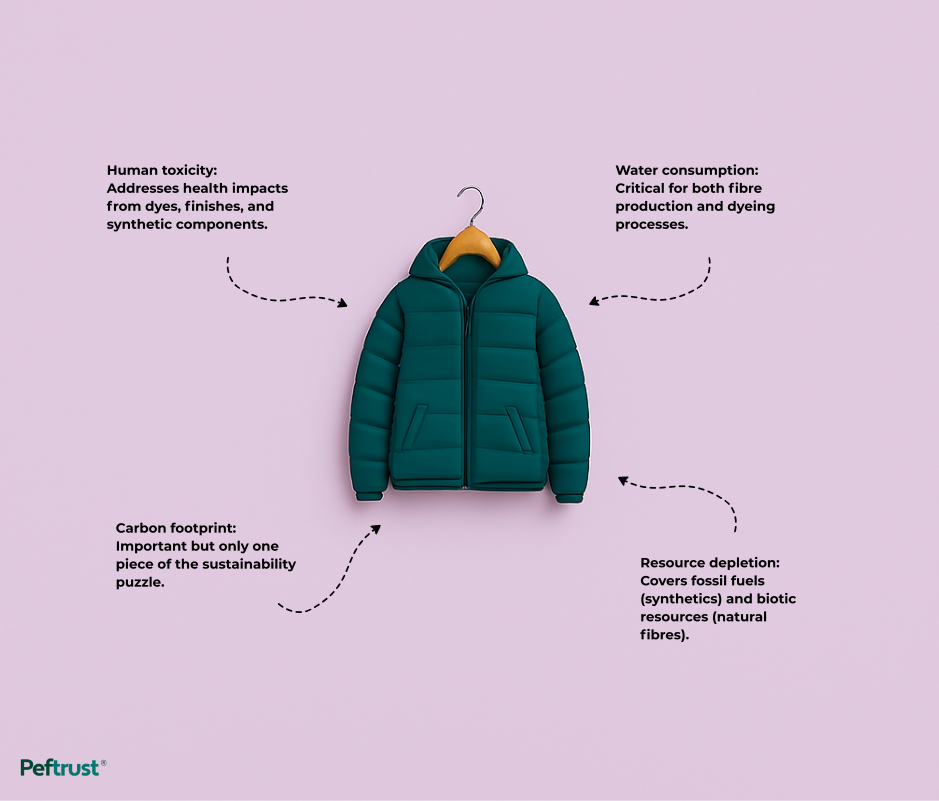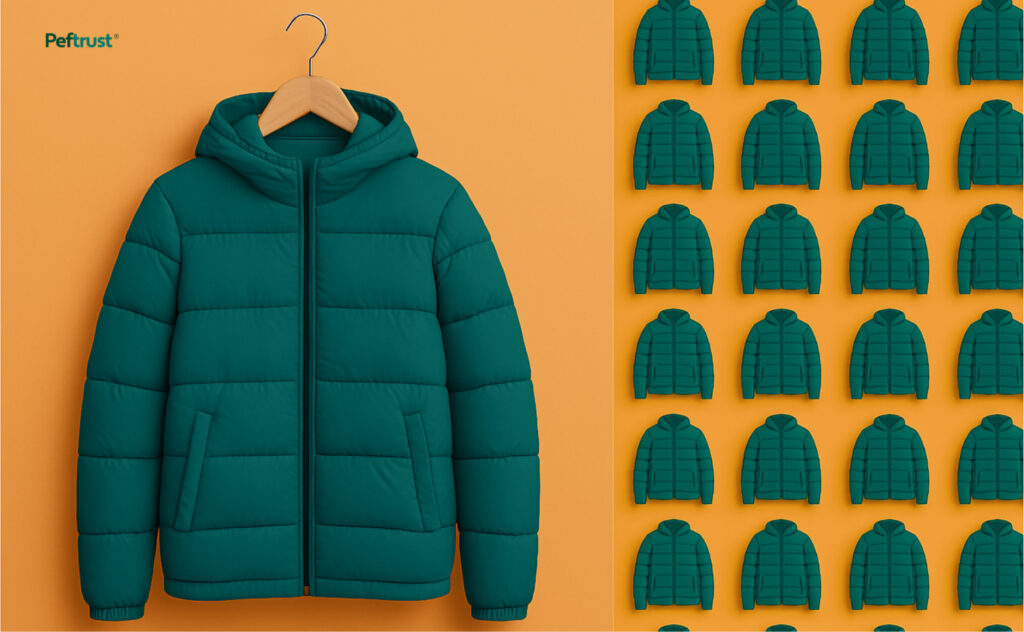What Should We Be Measuring in Mixed-Material Apparel?
This is a question we heard recently, directly from a client.
While our initial response was short and practical, we thought it deserved a deeper dive.
As sustainability becomes a core business requirement, brands involved in designing apparel that uses both natural and synthetic fibres must take a more comprehensive approach to environmental impact.
For example, the production of synthetic fibres, including polyester, is heavily reliant on petroleum, resulting in resource depletion and considerable greenhouse gas emissions. On the other hand, natural fibres, such as cotton, require substantial water resources and may contribute to environmental degradation
To navigate these challenges, our sustainability experts have identified several key factors that should shape ecodesign strategies:
1/ Water consumption
Critical for both fibre production and dyeing processes
2/ Human toxicity
Addresses health impacts from dyes, finishes, and synthetic components
3/ Resource depletion
Covers fossil fuels (synthetics) and biotic resources (natural fibres)
4/ Carbon footprint
Important but only one piece of the sustainability puzzle

By addressing these impact areas, brands can create more environmentally responsible products with a comprehensive sustainability perspective.
Leveraging platforms like Peftrust can further enhance this transition, providing the tools needed to improve sustainability across the industry.
Why Ecodesign Needs an Upgrade in 2025
Research indicates that up to 80% of a product’s environmental impact is determined during the design phase. Yet, many brands treat sustainability as an afterthought, focusing primarily on carbon emissions without considering other equally important factors.
As industries face increasingly complex environmental challenges, sustainability is no longer optional – it’s essential for business success and regulatory compliance. With evolving frameworks such as the Digital Product Passport (DPP) and Extended Producer Responsibility (EPR), brands must transition from good intentions to robust, data-driven ecodesign strategies that address the full spectrum of environmental impacts.
By implementing multi-impact assessment approaches in the design phase, brands can:
* Make evidence-based material and process selections
* Ensure compliance with emerging regulations
* Build consumer trust through transparent sustainability claims
At Peftrust, our recent Coffee Pause Webinar with industry expert, Gianluca Manago, highlighted that effective ecodesign requires a comprehensive understanding of the entire product life cycle – not just carbon reduction. This article shares key insights to help brands navigate the evolving ecodesign landscape.
Four Essential Ecodesign Principles Every Brand Should Know
1/ Multi-Impact Assessment: Moving Beyond Carbon
While carbon reduction remains crucial, focusing solely on carbon footprints creates significant blind spots in sustainable strategies. Apparel brands must evaluate the environmental trade-offs of their design choices. True sustainable design requires considering multiple environmental factors:
* Water consumption
Critical for manufacturing processes like textile dyeing, which heavily impacts freshwater resources
* Resource depletion
Affects both non-renewable resources (fossil fuels) and renewable resources (cotton, wood)
* Human toxicity
Chemicals in dyes, coatings, and finishes impact both environmental and human health
Neglecting these trade-offs leads to misleading sustainability claims and poorly informed design choices. As our demonstrations have shown, brands must adopt comprehensive impact assessments to make truly sustainable design decisions.
2/ Data-Driven Decision-Making: The Foundation of Effective Ecodesign
Accurate, structured data is the cornerstone of successful ecodesign implementation. Brands need reliable Life Cycle Assessment (LCA) methodologies to evaluate environmental trade-offs and identify areas for improvement.
Digital tools that streamline sustainability assessments help brands:
* Stay ahead of compliance requirements
* Enhance sustainability reporting accuracy
* Make informed material and process selections
Without high-quality data, brands risk inaccurate sustainability reporting and poor compliance with EU regulations such as the Product Environmental Footprint (PEF) methodology – the standardised approach for calculating environmental impacts.
Our LCA experts highlight that many industries struggle with obtaining granular environmental data, often relying on assumptions. Therefore, engaging diverse stakeholders is crucial for gathering accurate information and driving meaningful adoption.
Peftrust’s multi-impact LCA tools empower brands to make informed choices using structured, regulation-ready data that aligns with evolving industry standards.
3/ Colour Matters: The Hidden Environmental Impact of Colour Choices
Dyes and pigments influence far more than aesthetics—they significantly affect a product’s environmental footprint. The choice of colourants determines:
* Water usage
Some dyes require intensive water consumption, increasing resource strain
* Toxicity profiles
Certain synthetic dyes release harmful chemicals affecting ecosystems and human health
* End-of-life impact
Natural and synthetic colourants create different challenges for recycling and decomposition
By understanding these implications, designers and product teams can make more sustainable colour choices without compromising visual appeal. Integrating colour impact assessments into design processes ensures responsible material selection across industries.
4/ Human Expertise Remains Essential in the Age of AI
While artificial intelligence plays an increasingly significant role in sustainability analysis, human expertise remains indispensable. AI-powered tools can streamline data collection and basic assessments, but strategic decision-making requires human oversight:
* Interpreting complex environmental trade-offs
* Evaluating ethical considerations
* Applying industry-specific knowledge to findings
Our experts emphasise that AI is a powerful complement—not a replacement—for thorough, expert-led sustainability assessments.
Peftrust integrates AI-powered insights with expert-led decision-making, ensuring that sustainability strategies remain grounded in practical industry knowledge.
Ecodesign in Action: The Peftrust Platform Approach
Ecodesign focuses on minimising environmental impact throughout a product’s lifecycle. Our platform helps companies integrate eco-friendly materials, enhance durability, and implement energy-efficient processes. To illustrate the power of ecodesign, we examined a case study involving the redesign of a jacket, which demonstrated notable improvements in sustainability profile:

| Component | Original Material | Eco-Designed Material | Sustainability Rationale |
|---|---|---|---|
| Outer Shell | 61.86% PET (fossil-based) | 36% Post-consumer recycled PET + 24% fossil PET | Reduces carbon emissions and fossil resource use by replacing virgin PET with recycled inputs while maintaining performance |
| Padding | 25.77% Virgin polyester wadding | 21.25% Chemically recycled PET + 3.75% Recycled wool | Blending in natural recycled fiber reduces fossil use, supports circularity, and improves thermal regulation. |
| Lining | 10.31% Nylon 6 (fossil-based) | 10% Recycled nylon | Recycled nylon cuts environmental toxicity and fossil resource depletion |
| Trims | 2.06% PVC (fossil-based) | 3% Bio-based PE (e.g. sugar beet origin) | Switch to bio-based plastic reduces non-renewable input and improves circularity potential. |
| Coating/Finish | Fluorinated DWR coating (PFC-based) (assumed baseline) | 2% PVC monolithic coating (same for both) | Replacing PFC-based water repellents improves environmental and human health impacts, especially in wet weather gear. |
Key Impact Gains with Eco-Design
* ↓ 5% overall PEF score reduction
* Notable reductions in climate, resource depletion, and environmental health categories
* Strategic material swaps improve traceability, circularity, and compliance readiness (e.g. DPP, PEFCR)
Why 5% Matters
It might sound small — but apply this across a full collection with thousands of units, and the impact compounds dramatically.
One improved jacket → less carbon, less waste, better materials.
A hundred? A thousand? That’s where the future of scalable, sustainable design begins
Further improvements could be achieved by altering energy mixes, transportation modes, dyes, etc.
This example demonstrates how targeted material substitutions yield significant environmental improvements without compromising product quality.
Scaling Ecodesign with Peftrust Platform
The Peftrust ecodesign platform provides a comprehensive toolkit for sustainability improvement:
* See the full picture
Track your product’s environmental performance across key categories in intuitive views from products to full collections
* Comparative analysis library
Facilitates detailed comparisons between product designs, materials, and energy mixes to identify ROIs and align budgetary and sustainable targets
* Scenario modelling
Enables testing of different design approaches in real-time to maximise impact reduction before anything goes to production
* Material impact assessment
Quantifies how material changes affect environmental performance
* Comprehensive database precision
Leverages our secondary database of over 5,500 environmental datasets and tools to help map your primary data faster

Why Database Precision Matters: The Peftrust Advantage
When sourcing a tool for eco-design comparison, it’s crucial to ensure that the underlying database is comprehensive and reliable. A robust platform should provide a diverse dataset across materials—offering the depth necessary for accurate and meaningful comparisons, even when primary data is limited.
Peftrust stands out by combining a robust and evolving library of high-quality secondary data, your primary data and verified supplier or manufacturer-level inputs, enhancing the precision of each assessment.
This combination enhances the precision and provides tools that enable you to pinpoint areas for improvement and ensure that your assessments are informed, consistent, and credible, ultimately leading to more effective ecodesign decisions.
This robust foundation enables:
* More relevant impact assessments across product categories
* Accurate scenario-building and alternative modelling
* Informed decision-making aligned with sustainability goals and regulatory requirements
How Peftrust Supports Your Sustainability Journey
Whether you’re beginning your sustainability journey or scaling across multiple product lines, our tools make environmental improvement both seamless and impactful. Peftrust helps brands navigate the evolving ecodesign landscape with confidence by aligning with the following:

– European PEF methodology
The EU’s standardised environmental footprint calculation approach
– PEFCR Apparel and Footwear standards
Industry-specific environmental assessment guidelines
– ISO 14026 communication principles
International standards for environmental claims
AFNOR certification (the French standardisation association) has again validated our implementation of the Environmental Footprint Methodology. This third-party verification confirms our dedication to providing regulation-ready impact assessments for apparel & footwear. This gives brands the confidence that their results are credible, communicable, and audit-ready.
Take the Next Step in Your Ecodesign Journey
We invite you to experience how Peftrust can transform your approach to sustainable product design.
Contact Peftrust today to get a free custom Environmental Product Passport
